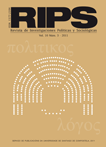Secularizaciones y Manifestaciones Religiosas
Contenido principal del artículo
Resumen
La secularización es un fenómeno fundamental para comprender las sociedades modernas. Pero si observamos las sociedades de comienzos del siglo XXI constatamos que lo religioso no solo no desaparece, sino que además surgen nuevas y plurales formas de religiosidad; además, lo secular no se impone definitivamente. Este hecho nos obliga considerar si la ‘teoría clásica de la secularización’ es válida –y si lo es en qué términos- para analizar ambos conceptos en la realidad social actual. Para ello, acudimos principalmente a dos fuentes: el trabajo de José Casanova Genealogías de la secularización (2012) -en el que propone una revisión de tres de las principales tesis asociadas a la secularización- y a los datos que nos proporciona el último Religions Monitor (Pickel, 2013) que realiza periódicamente la Fundación Bertelsmann. Tras el análisis realizado consideramos que, en el contexto actual, es más adecuado hablar de ‘secularizaciones’ y ‘manifestaciones religiosas’ que de ‘secularización’.
Palabras clave:
Citado por
10.5209/ilur.81827






